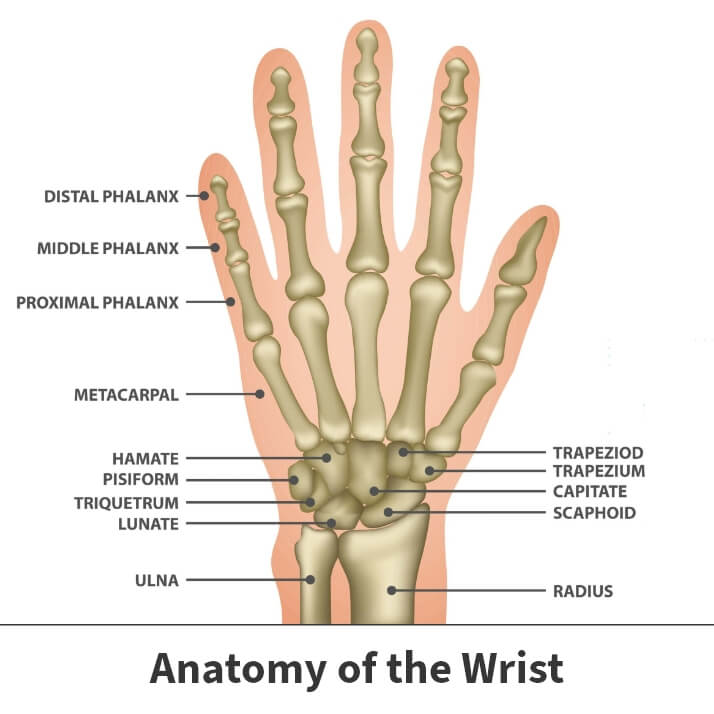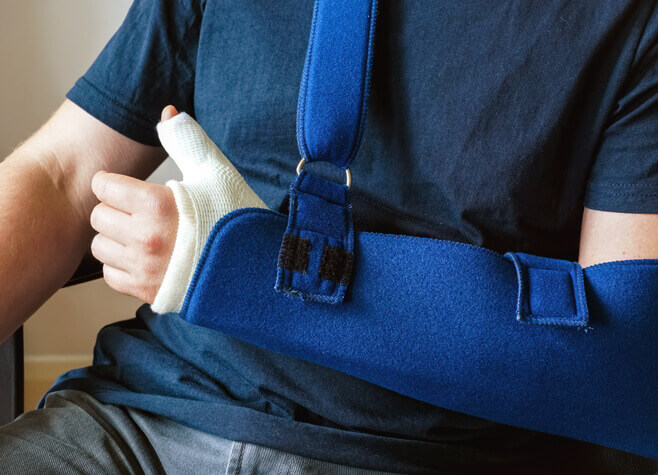Distal radius wrist fracture
Broken wrist
A distal radius fracture, also known as Colles’ fracture (and more simply known as a broken wrist), is an injury most commonly caused due to a hard fall onto the wrist. This particular type of fracture is typically simple to treat, though treatment is heavily dependent on if the bones remained in their correct alignment or not. Depending on how displaced the wrist bones are, surgery may be necessary to realign the bones.
Anatomy

The radius is the larger of the two bones of the forearm with the end toward the wrist called the distal end. A fracture of the distal radius occurs when the area of the radius near the wrist breaks.
About
A Colles’ fracture, also known as a broken wrist, is when the distal radius breaks, causing it to tilt upward. This fracture was first described in 1814 by an Irish surgeon and anatomist, Abraham Colles — hence the name Colles’ fracture.
The most common cause of a Colles’ fracture is a fall onto an outstretched arm. Another reason for this particular type of fracture is osteoporosis, a disorder that causes bones to weaken over time.
The best way to prevent Colles’ fractures is by maintaining good bone health and wearing wrist guards during activities that can result in a fall, such as skateboarding.
Symptoms
A broken wrist usually causes immediate pain, tenderness, bruising, and swelling. Often, the wrist hangs in an odd or bent way (deformity).
Diagnosis
Your Florida Orthopaedic Institute physician will look at your symptoms and medical history to help determine if you have a Colles’ fracture. Your physician will also order X-rays of your wrist, which produce an image of your wrist bones. This image will show if the wrist was displaced and how many pieces of broken bone there are. This information is essential to know how to treat your fracture.
Treatment
The most important part of the treatment process for a Colles’ fracture is to make sure the broken bone pieces are in the correct alignment before they heal, and that they stay in place. Beyond that, there are both surgical and nonsurgical treatment options available to treat this type of fracture.
Nonsurgical treatments
When the broken bone is positioned correctly, a cast is applied until the bone heals. If the bone is not too severely displaced, a closed reduction may be necessary before casting. During a closed reduction, the bone is realigned without having to cut into the arm. For the best results, a closed reduction must be done as soon after the injury as possible.
Depending on the type of fracture you have, your physician will closely check the healing by taking regular X-rays. The quantity and frequency of X-rays you would need also depend on the severity and type of your fracture.
After about six weeks, the cast can be removed. At that point, physical therapy is often started to help improve the motion and function of the injured wrist.
Surgical treatments
If the bone is so displaced that it cannot heal correctly, even if put in a cast, surgery will be necessary. The procedure most commonly used is called open reduction and internal fixation. During the procedure, an incision is made to allow access to your broken bones.
Depending on the fracture, there are several options for holding the bone in the correct position while it heals:
- Cast
- Metal pins (usually made of stainless steel or titanium)
- Plate and screws
- External fixator (a stabilizing frame outside the body that holds the bones in the proper position so they can heal)
- Any combination of these techniques

Videos
Related specialties
- Basal Joint Surgery
- Carpal Tunnel Syndrome
- De Quervain's Tenosynovitis
- Dislocated Finger
- Dupuytren’s Disease
- Flexor Tendonitis
- Fractured Fingers
- Functional Nerve Transfers of the Hand
- Ganglion Cysts
- Hand & Finger Replantation
- Hand Nerve Decompression
- Hand Skin Grafts
- Nerve Pain
- Peripheral Nerve Surgery (Hand) Revision
- Revascularization of the Hand
- Rheumatoid Arthritis of the Hand
- Sports Wrist & Hand Injuries
- Sprained Wrist
- Sudden Acute Finger, Hand & Wrist Injuries
- Targeted Muscle Reinnervation (TMR)
- Tendon Transfers of the Hand
- Thumb Ulnar Collateral Ligament Injuries
- Trigger Finger
- Ulnar Neuritis
- WALANT (Wide Awake Local Anesthesia No Tourniquet)
- Wrist Arthroscopy
- Wrist Fractures
- Wrist Tendonitis
